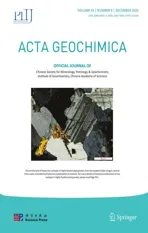The Bafoussam volcanic series: origin and evolution of the volcanism along the Cameroon volcanic line
2022-12-22PhilippeEssombaGillesChazotNicaiseBlaiseTchuimegnieNgongangArnaudAgranierPierreKamgangHervBellonPhilippeNonnottePierreWotchokoInnocentBadriyo
Philippe Essomba • Gilles Chazot• Nicaise Blaise Tchuimegnie Ngongang •Arnaud Agranier • Pierre Kamgang • Hervé Bellon • Philippe Nonnotte •Pierre Wotchoko • Innocent Badriyo,5
Abstract The Bafoussam area in western Cameroon is part of the central Cameroon Volcanic Ligne(CVL).This study presents the mineralogy, major and trace element compositions,Sr-Pb-Hf isotopes,and new K–Ar geochronological data about mafic and felsic volcanic rocks.These rocks belong to two different series:A transitional series made of basalts, basaltic andesite, and trachytes and an alkaline mafic series with basalts,hawaiites,and basanites.New age data show that the transitional series belongs to the oldest part of the CVL and was emplaced between 47 and 35 Ma.The alkaline volcanism is younger,with ages ranging from 10 to 4.5 Ma.
Keywords Cameroon Volcanic Line ∙Bafoussam ∙Mafic volcanic rocks ∙Felsic volcanic rocks ∙Mantle source
1 Introduction
The Cameroon Volcanic Line (CVL) is an alignment of volcanoes stretching over a distance of 1700 km (Njome and De Wit 2014) from the Atlantic Ocean (Gulf of Guinea) to mainland Africa.The CVL is divided into three segments: the oceanic sector (Annobon, Sao Tome, and Principe), the continental/oceanic boundary (c.o.b.: Bioko,Etinde, and Mount Cameroon), and the purely continental sector.This last part of the CVL is marked by a trend of large massifs including the Manengouba, Bambouto,Bamenda, and Oku mountains (Kamgang et al.2010, 2013).The volcanic activity developed from the upper Cretaceous (68.8 ± 1.7 Ma, Ngonge et al.2014) to present with the eruptions of Mount Cameroon of March–April 1999 and May–July 2000 (Suh et al.2003).CVL lavas are typically characterized by alkaline(Marzoli et al.2000;Kamgang et al.2013;Pouclet et al.2014;Merle et al.2017;Gountié Dedzo et al.2019),transitional(Fosso et al.2005; Kuepouo et al.2006; Moundi et al.2007; Okomo Atouba et al.2016; Ziem a` Bidias et al.2018; Lemdjou et al.2020), and rare tholeiitic rocks (Ngounouno et al.2001).The above studies support the evolution of silicic lavas by fractional crystallization of the mafic melts,accompanied by crustal contamination.This contamination has been demonstrated by Kamgang et al.(2013)in Mount Bamenda and by Tchuimegnie Ngongang et al.(2015) in the Bafang volcanic area.Concerning the origin of the magmas,several detailed investigations of the petrography and geochemistry of volcanic rocks have been carried out to understand the source of lavas of the CVL and their evolutions.Several hypotheses have been suggested: Halliday et al.(1988, 1990) proposed the destruction of the lithosphere and the impregnation of the uppermost mantle by the St.Helena hot spot during the formation of the South Atlantic Ocean.This mantle was subsequently melted to form the Cameroon line which appears to be derived from a rising hot zone initiated by the early plume activity; for Lee et al.(1994), the Cameroon Line originates from a sublithospheric enriched ‘‘hot zone’’ periodically fed by melted deep mantle plumes, and this zone of hotter mantle represents reactivated mantle previously enriched during the opening of the South Atlantic in the Mesozoic.Marzoli et al.(1999) concluded that the Cameroon volcanic line as a whole may not be interpreted as the surface expression of simple hotspot magmatism,confirming earlier conclusions of Fitton and Dunlop(1985)and Fitton (1987), drawn from a more restricted database.However, certain recent geological data also show that the lavas of the CVL do not have the same mantle sources as the St.Helena mantle plume, suggesting that the plume is not the source of the CVL (Marzoli et al.2000;Rankenburg et al.2005; Yokoyama et al.2007;Tchuimegnie Ngongang et al.2015; Merle et al.2017;Ziem a` Bidias et al.2018; Lemdjou et al.2020).In other hypotheses, the development of volcanism has been linked to several hotspots (Ngounouno et al.2003; Ngako et al.2006; Déruelle et al.2007) or tectonics and small-scale convection in the upper mantle at the base of the lithosphere (King and Ritsema 2000; Reusch et al.2011; De Plaen et al.2014; Adams et al.2015).
To contribute to this debate,we perform a detailed study of volcanic rocks of the Bafoussam area,located within the Western Cameroon highlands in the central part of the CVL (Fig.1a and b).This zone is bounded by Mount Bambouto to the North-West,Mount Bangou to the South,Bamoun plateau to the East, and Bafang volcanic area to the South-West which shows that the volcanic activity was very important in this region.The previous geologic studies on volcanism were focused on the above-mentioned volcanic edifices, thus leaving large surfaces of lava plateau without detailed geologic data.This study presents petrographic, mineral, and whole-rock chemical data, K–Ar ages, and Sr-Pb-Hf isotopes on some volcanic rocks from the Bafoussam area.
2 Geological setting and previous work
The Bafoussam volcanic area is located within the Western Cameroon Highlands in the central part of the CVL.It is dominated by fissural volcanism and exhibits volcanic lava outcrops called‘‘plateau basalt’’.These outcrops occur in a vertical or inclined prism, blocks and balls clustered or scattered and result from partly eroded lava flows.The lavas sampled in this area are mafic, intermediate, and felsic.The volcanic rocks lie on a Pan-African (650 Ma)granitoids discontinuous basement (Djouka-Fonkwe et al.2008).The previous works based on macroscopic descriptions show that this area is composed of aphyric or porphyritic basalts and andesites (Dumort 1968; Tchoua 1974).However, many volcanic studies have been carried out in some neighbouring localities like Bangou (Fosso et al.2005), Bana (Kuepouo et al.2006), Bafang(Tchuimegnie Ngongang et al.2015), Bamoun plateau(Moundi et al.2007; Okomo Atouba et al.2016; Ziem a`Bidias et al.2018),the eastern edge of the West Cameroon Highlands (Lemdjou et.2020) and Fotouni (Ngongang Tchikankou et al.2020).According to these authors, the lavas are mafic and intermediate and are of transitional and alkaline affinity.

Fig.1 a Location map of the Cameroon Volcanic Line;the main geologic features of Africa are indicated.b Generalized map of the Cameroon Volcanic Line(Halliday et al.1988),with the location of the Bafoussam volcanic area.Orientation of seamounts after Burke(2001).c Simplified geological map of the studied area and location of the samples
3 Analytical methods
3.1 K–Ar geochronology
Potassium-argon ages were measured at the Université de Bretagne Occidentale, in Brest (France) on chips of whole rock lavas, 0.3–0.15 mm in size, that were prepared after crushing and subsequent sieving of the solid samples.The preparation and analysis methods are the same as described in Tchuimegnie Ngongang et al.(2015).Isotopic dilution was performed using the method described in Bellon et al.(1981).
3.2 Major and trace element analyses
Whole-rock major elements were measured on the Horiba-Jobin–Yvon® Ultima 2 ICP-AES at the IUEM (European Institute for Marine Studies, Brest, France).A detailed description of the analytical procedure is given in Cotten et al.(1995) and the data presented here were obtained using the same methods as described in Tchuimegnie Ngongang et al.(2015).
Trace element concentrations were measured with a Thermo Element 2 HR-ICP-MS in Brest(France),with the same procedure as described in Tchuimegnie Ngongang et al.(2015).
3.3 Sr-Pb-Hf isotopic analyses
Pb and Hf isotope compositions were analyzed using the Thermo Neptune MC-ICP-MS of IUEM (Brest) and Sr isotopic measurements were performed on a Thermo Scientific Triton in the same laboratory.2σ internal errors never exceeded the last significant digit (1E-5) in each analysis.All the analytical parameters and identical to those described in Tchuimegnie Ngongang et al.(2015).
4 Nomenclature and petrography
4.1 Nomenclature
All major-element compositions were recalculated to 100%on an anhydrous basis.The Bafoussam volcanic rocks have been classified using the TAS diagram(Le Bas et al.1986;Fig.2a) with the alkaline-subalcaline dividing line of Irvine and Barragar(1971).According to this diagram, the samples plot in basanite,hawaiite,basalt,basaltic andesite,and trachyte fields.A clear two groups compositional distribution in terms of SiO2content is observed: mafic(45.7–52.6 wt.%) and felsic (63.6–63.8 wt.%) groups.In the Na2O vs.K2O diagram of Middlemost(1975)shown in Fig.2b, all the mafic lavas plot in the Na-series field(Na2O/K2O = 2.10–4.46).
4.2 Petrography
The Bafoussam lavas include mafic and felsic rocks,which can be divided into three groups according to their mineral assemblage and magmatic affinity: mafic alkaline lavas(basanite, hawaiite, and basalt), mafic transitional lavas(basalt and basaltic andesite) and felsic transitional lavas(trachyte).
Mafic alkaline lavas usually have microlitic porphyritic textures (Fig.3a and b).They contain plagioclase,clinopyroxene,olivine,and Fe-Ti oxides as microlites,with fluidal texture.Plagioclase and clinopyroxene and rare olivine microcrysts and phenocrysts are scattered in the groundmass.
Mafic transitional lavas have microlitic porphyritic or microlitic aphyritic texture with a fluidal tendency(Fig.3c).Their mineral assemblage remains constant.The plagioclases, pyroxenes, and opaque minerals constitute the essence of the phenocrysts.Olivine is absent or occasional.The mineral assemblage of basaltic andesite is almost identical to that of transitional basalts.Nevertheless,it is slightly more differentiated.
Felsic transitional lavas have a microlitic fluidal or trachytic texture (Fig.3d).The microscopic characteristic shows that the trachytes are dominated by microlites and phenocrysts of sanidine.The other representative minerals are microlites of feldspar and microphenocrysts of oxides,pyroxene, and quartz.
5 Mineral chemistry
5.1 Olivine
Olivine is present in the alkaline lavas as phenocryst,microphenocryst, and microlite and rare/or absent in the transitional lavas.Representative microprobe analyses of olivines are given in Supplementary Material.The chemical composition has a range that evolves from forsteriterich (Fo71.2) to forsterite-poor (Fo49.1) olivine.Olivine in alkaline basalt (Fo64.9–71.2), basanite (Fo65.1–70.9), and hawaiite (Fo65.5–66.5) have the highest forsterite content.It is more Fe-rich in the transitional basaltic andesite(Fo67.4–49.1).The high CaO contents >0.18 wt.% (except for one analysis in olivine of alkaline lavas) reflect low pressures of crystallization, typical of crustal conditions(Ko¨hler and Brey 1990; Hirschmann and Ghiorso 1994)and higher than that of peridotites(<0.1 wt.%,Simkin and Smith 1970).CaO and NiO concentrations in the alkaline lava olivines are generally higher than those in transitionallavas.MnO contents are very low in almost all types of lavas,except for three points of analyses of alkaline basalt.

Fig.2 a Total Alkalis vs.Silica diagram(Le Bas et al.1986)for the Bafoussam lavas.The dotted line is from Irvine and Barragar(1971).b Na2O vs.K2O subdivision diagram of K- and Na-series of mafic lavas(Middlemost 1975).In these diagrams and in all the following dealing with major and trace elements as well as isotopic ratios, analytical uncertainties are lower than the symbol size
5.2 Pyroxene
Representative analyses of pyroxenes are listed in Supplementary Material.In the Wo-En-Fs classification diagram of Morimoto et al.(1988), the pyroxene of the two groups of rocks (alkaline and transitional) are mainly diopside, augite with minor pigeonite and clinoenstatite(Fig.4a).The clinopyroxenes of alkaline lavas plot in the augite and diopside fields.The wollastonite content is higher in diopside(Wo45.3–48.3En35.9–40.7Fs12.4–15.6)than in augite (Wo39.7–44.8En39.4–48.5Fs11.7–15.9).The clinopyroxenes of the transitional lavas plot in the augite field and have low wollastonite content (Wo37.2–42.6En35.3–40.9Fs18.7–26.2).Orthopyroxenes are only found in the transitional lavas(Wo4.5–4.8En39.3–65.5Fs29.9–45.7) and are sometimes associated with pigeonite.Their geochemical composition is very variable in MgO (13.36–23.78 wt.%) and FeO(19.34–28.85 wt.%).They are low in CaO (2.28–7.03 wt.%) and Na2O (0.05–0.15 wt.%).The unique analysis of pigeonite is poor in Mn (0.86 wt% MnO) compared to those described in the Mbabo volcano massif of the CVL(3.3–3.6 wt% MnO; Bardintzeff et al.2020).
Diopside (CaMgSi2O6) is the simplest clinopyroxene structural formula,where Ca occupies the M2 site,Mg is in the octahedral M1 site and Si is tetrahedrally coordinated.Substitution of divalent cations Fe, Mn, and Mg for Ca in the M2 site and Fe and Mn for Mg in the M1 site produces the compositional variations observed in the pyroxene quadrilateral (Farahat et al.2006).However, almost all pyroxene analyses of the alkaline lavas contain an excess of aluminum after allocation of Al to the tetrahedral site,contrarily of transitional lavas(Fig.4b).Titanium contents are positively correlated with Mg# (Fig.4c).According to Binns et al.(1970), the Al and Ti contents of calcic-pyroxene reflect the silica activity of the magma and the crystallization conditions, with high Al and Ti contents being associated with low Si activities and elevated pressures.Accordingly, the relatively high Al and Ti contents of pyroxene from most of the alkaline lavas, reflect their crystallization at relatively high pressure and low silica activity compared to those from transitional lavas.It is of petrological importance to note the significant difference in the Si, Al, Ti, Na, and Mg# = [100*Mg/(Mg + Fe2+)]between pyroxenes of the two groups of lavas(alkaline andtransitional).Pyroxenes of the alkaline lavas have higher values in Al, Ti, Na, and Mg# compared to those of transitional lavas.
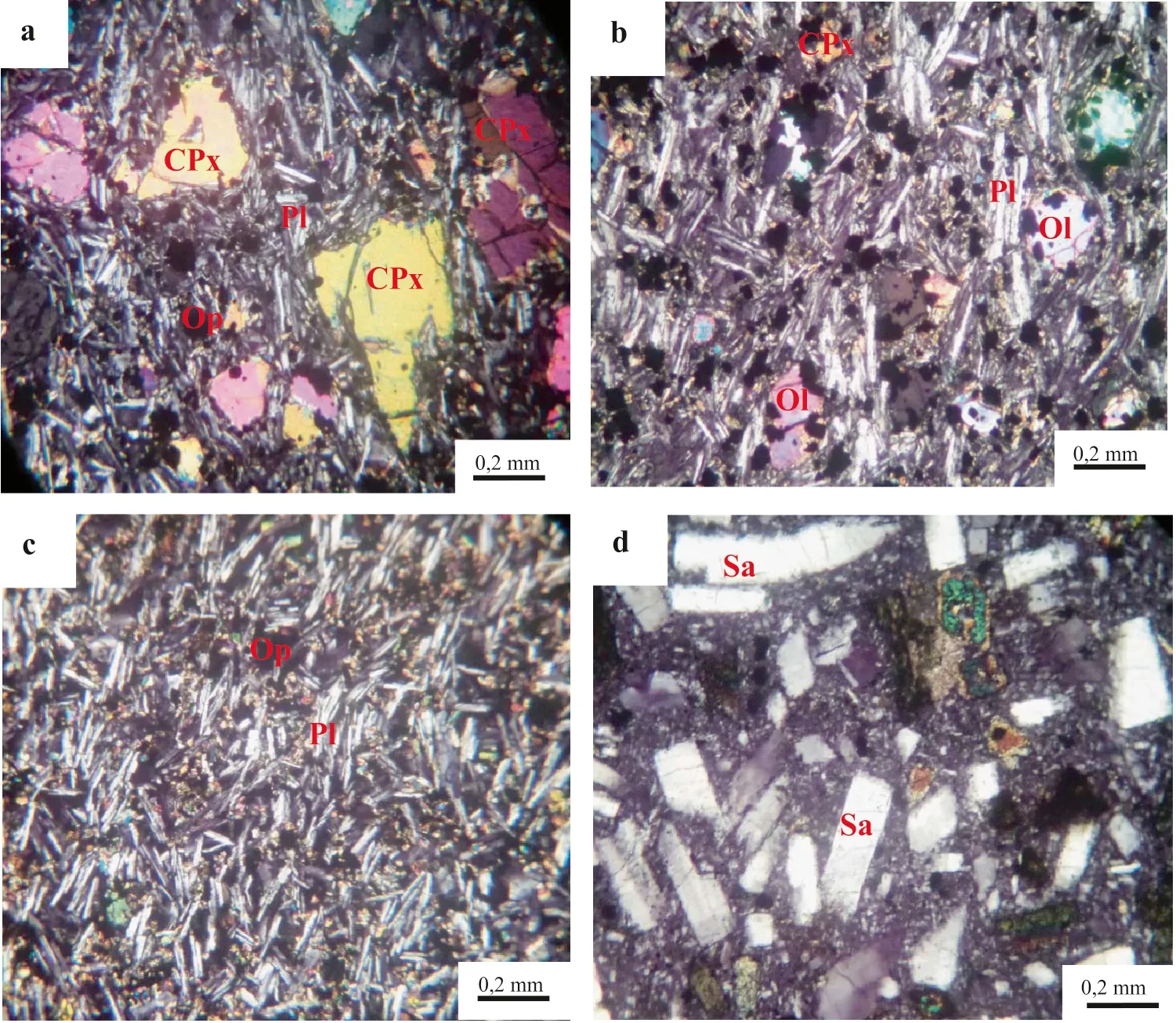
Fig.3 Photomicrographs of thin sections of mafic and felsic lavas from the Bafoussam area.a and b Microlitic porphyritic texture of alkaline lavas(hawaiite and basanite,respectively).c Microlitic aphyritic texture with the fluidal tendency in a transitional basalt.d Trachytic texture with microlites and phenocrysts of sanidine in transitional trachyte.Cpx = clinopyroxene,Pl = plagioclase, Ol = olivine,Sa = sanidine and Op = opaque mineral

Fig.4 (a) Compositions of pyroxenes plotted in the atomic Mg-Fe-Ca ternary diagram(boundaries after Morimoto et al., 1988).b and c Cation variations in pyroxenes.CPFU = cation per formula unit.Legend in Fig.2
5.3 Feldspar
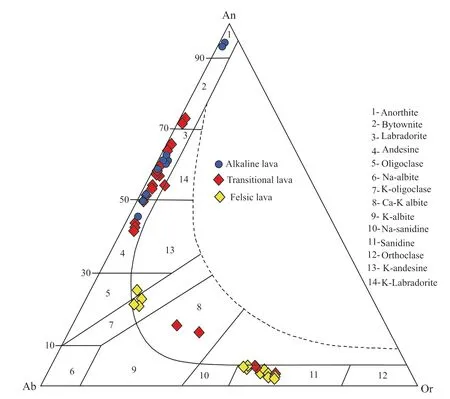
Fig.5 Nomenclature of feldspars(Smith and Brown,1988)analyzed in the transitional and alkaline rocks
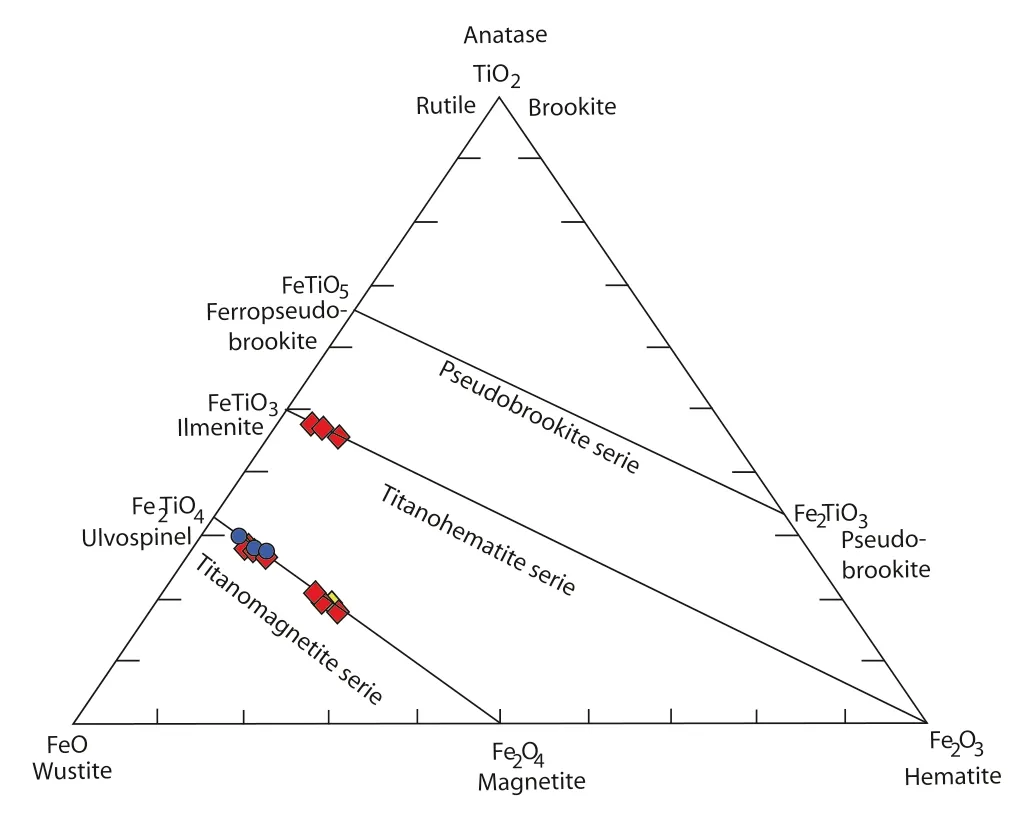
Fig.6 a Chemical composition of Fe-Ti oxide minerals in the Bafoussam lavas.Legend in Fig.2
Feldspar represents the main mineral phase in the Bafoussam lavas.Their compositions are shown in Supplementary Material.These feldspars evolve in two different series: plagioclase and alkali feldspar.The plagioclases range from andesine to anorthite compositions in the alkaline lavas (An46.9–51.1–An94.0–94.3respectively)and from andesine to bytownite (An43.1–44.8–An73.2–74.4respectively) in the transitional lavas but are mainly labradorite in the two groups (Fig.5).Alkali feldspars occur in the transitional and felsic lavas.Their composition ranges from sanidine to Ca-K-albite in the transitional lavas (An3–6–An14respectively) and from sanidine to K-oligoclase (An3–5–An22–24respectively) in the felsic lavas.
5.4 Fe-Ti oxide
Representative analyses of Fe-Ti oxides are listed in Supplementary Material.The ternary plot of TiO2-FeO-Fe2O3shows ilmenite-hematite and magnetite-ulvo¨spinel trend evolutions (Buddington and Lindsley 1964; Fig.6).These Fe-Ti oxides comprise mainly titanomagnetite and ilmenite occurring as groundmass microlites.The ilmenites have a low composition in hematite (Fe2O3) in solid solution(Ilm97.2–96.2Hem3.7–2.7).Magnetite occurs as Ti-magnetite with high contents of ulvo¨spinel end-member (Fe2TiO4)and very low in magnesioferrite (MgFe2O4) end-members in transitional and felsic lavas,and Ti-magnetite rich in the ulvo¨spinel end-member in alkaline lavas.The chemical compositions of Usp-Mt vary from basanites (Usp76.6-Mt23.3) to hawaiites (Usp82.5–79.3Mt20.6–17.4) in the alkaline lavas.In the transitional lavas, these compositions show a large variation (Usp73.7–46.7Mt53.2–26.2).Only one analysis was carried out in the trachytes and it has a chemical composition of Usp49.4Mt50.5.
6 Whole-rock geochemistry
6.1 Major and trace elements
The major and trace element contents of the rocks are presented in Table 1.The compositions of the various oxides were recalculated to 100% based on a hydrous-free basis.The samples show a range in SiO2from 45.7 to 63.8 wt% but there is a gap in the silica content with no intermediate lavas.The mafic lavas have alkaline and transitional affinity and the felsic lavas are transitional.The Mgnumber values (100xMg/Mg + Fe in mol), assuming FeOt = Fe2O3*0.8998) vary from 39.8 to 50.1 in mafic alkaline, from 20.4 to 39.3 in mafic transitional and from 2.7 to 3.2 in felsic transitional lavas.Alkaline lavas are nepheline and olivine normative,whereas transitional lavas(mafic and felsic) are hypersthene and quartz normative(Table 1).The major element variations with respect to Th content are illustrated in Fig.7.Negative correlations of MgO and CaO with Th and positive correlations of K2O with Th suggest variable degrees of fractional crystallization as the main evolutionary process for the mafic transitional and alkaline lavas.In the Al2O3vs.Th diagram,we observe an almost constant evolution between some samples of the alkaline and transitional mafic lavas; this indicates that there was no plagioclase fractionation in both groups of lavas.However, some samples from the transitional mafic lavas have low and almost similar Al2O3contents to the felsic lavas, suggesting that a contaminant that was poor in Al2O3diluted its concentration in these lavas.

Table 1 Major (wt.%) and trace (ppm) element concentrations and normative composition for the Bafoussam lavas

Table 1 continued
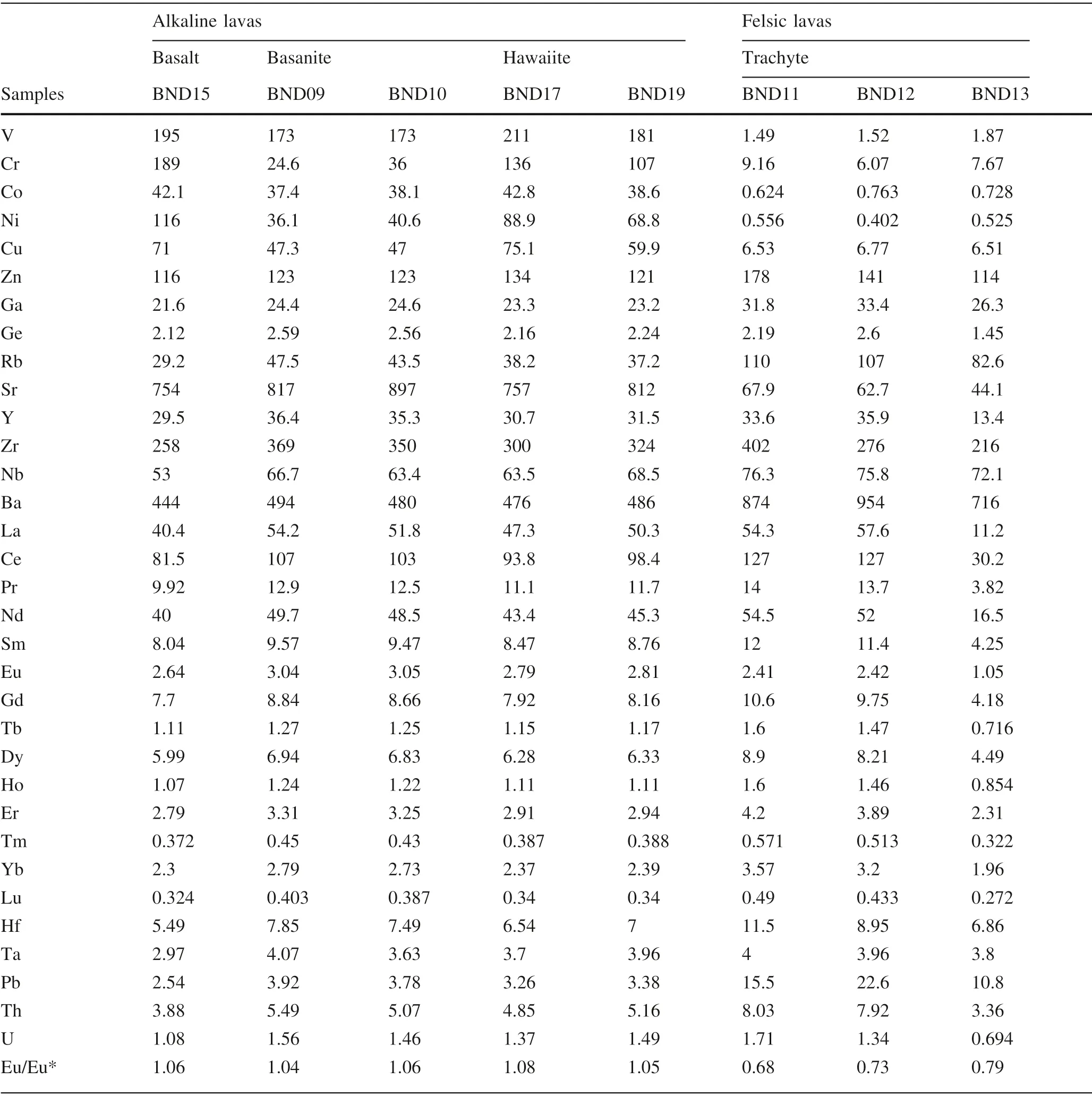
Table 1 continued
The compatible elements show a wide range of Ni and Cr values for an almost constant value of SiO2for the alkaline lavas and scattered values for the mafic transitional lavas contrary to the felsic transitional lavas which have very low and constant values.These Ni and Cr values are much lower than 300 and 600 ppm respectively, so the magmas are not primary (Ni: 250–300 ppm and Cr:500–600 ppm e.g.,Green 1976;Kimura and Ariskin 2014).The evolution of incompatible elements shows positive correlations of La, Zr, Nb, and Sr with Th (Fig.8).
Chondrite-normalized rare earth element(REE)patterns(McDonough 2003)of the Bafoussam samples are enriched in light REE [alkaline lavas (La/Yb)n= 11.9–14.3, transitional lavas (La/Yb)n= 3.4–7.7 and felsic lavas (La/Yb)n= 3.9–12.2; where the subscript n means chondritenormalized](Fig.9a,b and c).These values are higher than those of N-MORB and E-MORB [(La/Yb)n= 0.56 and 1.81 respectively; Sun and McDonough 1989].In Fig.9b,some samples of transitional lavas exhibit weak/or high positive europium anomalies (Eu/Eu* = 1.05–1.39, where Eu is normalized Eu and Eu* is Eu interpolated between normalized Sm and Gd: Eu* = Eu/(Smn× Gdn)1/2.This anomaly is absent in alkaline lavas (Eu/Eu* = 1.04–1.08;Fig.9a).All samples of felsic transitional lavas show negative europium anomalies (Eu/Eu* = 0.68–0.79;Fig.9c), as evidence of fractional crystallization of feldspar.

Fig.7 Whole rock major element composition (in wt.%)versus Th (in ppm) for the transitional and alkaline rocks

Fig.8 Variations of some trace elements (in ppm)versus Th(in ppm).Legend in Fig.8
The trace element patterns of mafic alkaline and transitional lavas normalized to the primitive mantle(McDonough 2003) share the same OIB-like intraplaque characteristics with enrichment in highly to moderately incompatible trace elements (Fig.9d and e).All alkaline lavas display highly fractionated patterns with negative K and Pb anomalies,and positive Nb, and Ba anomalies.Transitional lavas exhibit negative Th,K,Pb,Sr,Zr-Hf anomalies and positive Nb,Ba,Eu anomalies.Felsic transitional lavas patterns show positive K,Pb,and Y anomalies and negative Sr,Eu,and Th-U anomalies(Fig.9f).
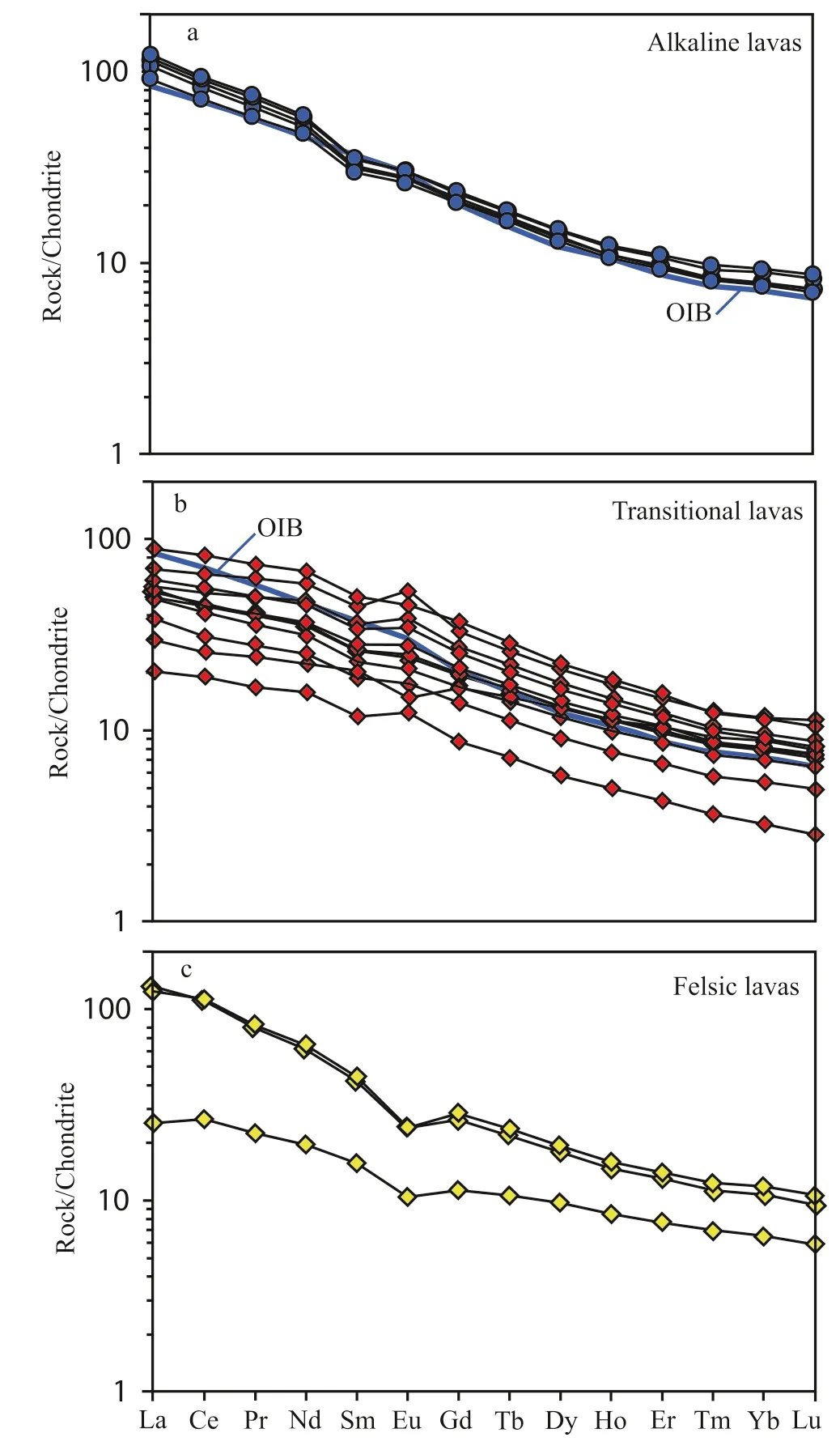
Fig.9 a, b, c Rare earth element (REE) patterns normalized to chondrite values (McDonough, 2003) for the Bafoussam lavas; d, e,f Extended trace element patterns normalized to the composition of the primitive mantle (McDonough 2003).OIB values from Sun and McDonough (1989)

Fig.9 continued
6.2 Sr, Pb, and Hf isotope geochemistry
The Sr, Pb, and Hf isotopic ratios of five mafic alkalines,eleven mafic transitional, and three felsic transitional samples are listed in Table 2.The initial isotopic ratios(87Sr/86Sr) have been recalculated at 7 Ma for the mafic alkaline, 41 Ma for the mafic transitional, and 44 Ma for the felsic transitional lavas, for samples that have not been dated.The other samples have been recalculated with their absolute ages.The values of the initial87Sr/86Sr ratios of alkaline lavas (0.70293–0.70321) are lower than those of mafic transitional(0.70374–0.70536)and felsic transitional(0.70575–0.70703) lavas, and their measured176Hf/177Hf ratios (0.28295–0.28299) are higher than in mafic transitional (0.28278–0.28292) and felsic transitional(0.28257–0.28258)lavas.The208Pb/204Pb,207Pb/204Pb and206Pb/204Pb ratios of alkaline lavas (39.498–39.917,15.619–15.655 and 19.785–20.193,respectively)are higher than those of mafic transitional lavas (38.519–39.246,15.535–15.623 and 17.979–18.991, respectively).Felsic transitional lavas have higher208Pb/204Pb and207Pb/204Pb ratios than the mafic transitional lavas (39.611–39.633,15.660–15.662,respectively),for similar206Pb/204Pb ratios(18.396–18.401).
In Fig.10, the variations of Sriand Pb isotopic compositions of mafic lavas follow the evolution of those of theCVL and reflect the heterogeneous nature of the mantle source.Alkaline lavas are close to the Mount Cameroon domain.Some mafic transitional lavas show low radiogenic Pb and high Sr ratios, suggesting that they interacted with the crust on their way to the surface.

Table 2 Sr, Hf and Pb isotopic compositions of Bafoussam lavas
7 Geochronology
Eight samples were subjected to K–Ar dating.The Ar isotopic data and calculated ages for the samples are presented in Table 3.The ages range from middle Eocene(47 Ma) to Pliocene (5 Ma).The volcanic events in the Bafoussam area took place in two periods: a mafic and felsic transitional volcanic episode between 47–35 Ma(divided into two episodes: a mafic and felsic transitional between 47–44 Ma and a transitional around 37–35 Ma)and an alkaline volcanic episode between 10 and 5 Ma.The mafic and felsic transitional episodes are in the interval of transitional volcanism of the Bamoun, Bangou, and Fotouni areas(K–Ar ages of 51–39 Ma; Fosso et al.2005;Moundi et al.2007;Okomo Atouba et al.2016;Ngongang Tchikankou et al.2020) and transitional episode to that of the eastern edge of the West Cameroon Highlands (K–Ar age of ~37 Ma; Lemdjou et al.2020).The alkaline period corresponds to alkaline volcanic eruptions in the Bangou, and Bamenda mountains and the volcanic areas of Bafang, and the eastern edge of the West Cameroon Highlands (K–Ar ages of 10–4 Ma; Fosso et al.2005;Kamgang et al.2013; Tchuimegnie Ngongang et al.2015;Lemdjou et al.2020).
8 Discussion: Origin and evolution of the magmas
8.1 Fractional crystallization and crustal contamination
The alkaline lavas show a very limited range of chemical evolution (Fig.7).A strong decrease in MgO content associated with a low decrease in CaO and a constant or increasing Al2O3content with increasing Th indicates early fractionation of olivine and clinopyroxene.
Crystal fractionation tendencies are not clear in the transitional lavas, probably because they belong to different magmatic series of different ages.Decreasing MgO,CaO, and TiO2confirm the fractionation of clinopyroxene and oxides, as observed from the nature of phenocrysts in the lavas (Fig.7).However, the near-constant Al2O3content shows that plagioclase is not a major mineral phase during differentiation and this observation is confirmed by the constant Sr content in these rocks (Fig.8).Some samples appear to have lower Al2O3content,but it will be shown later on that these samples are those who suffered crustal contamination.The felsic transitional lavas are highly evolved, and their very low content in MgO, CaO,and TiO2is consistent with an evolution from the transitional mafic magmas through crystal fractionation.As for the mafic transitional rocks, their high Al2O3content is close to 14 wt.% indicates that plagioclase was not an important fractionating mineral during magma evolution in the transitional series.

Fig.10 Isotopic compositions of the Bafoussam volcanic rocks:(a) 207Pb/204Pb vs.206Pb/204Pb;(b) 208Pb/204Pb vs.206Pb/204Pb;(c)(87Sr/88Sr)i vs.206Pb/204Pb(d) 176Hf/177Hf vs.206Pb/204Pb.Principé,Sao Tomé and Pagaluˆdata from Lee et al.(1994).The grey fields represent the data for the CVL and Mt.Cameroon(Halliday et al.1988;Lee et al.1994;Ballentine et al.1997;Marzoli et al.2000;Rankenburg et al.2005;Yokoyama et al.2007; Tsafack et al.2009; Kamgang et al.2013).St.Helena data from Chaffey et al.(1989), Hanyu et al.(2014), and Salters and White(1998).Data for Fotouni are from Ngongang Tchikankou et al.(2021), Bamoun Plateau from Okomo Atouba et al.(2016) and Bafang from Tchuimegnie Ngongang et al.(2015).Depleted MORB Mantle(DMM),Enriched Mantle 1(EM1),Enriched Mantle 2(EM2),High U/Pb Mantle(HIMU) from Hart(1984, 1988),Zindler and Hart(1986), Hart et al.(1992)and Hanan and Graham (1996).Legend as in Fig.2.Red symbols with a cross represent the contaminated mafic lavas

Table 3 K–Ar ages of Bafoussam lavas

Fig.11 a La/Nb vs.Th diagram for alkaline, transitional and felsic lavas from Bafoussam.b 87Sr/86Sr vs.Th diagram for the Bafoussam Lavas.Assimilation-Fractional Crystallization (AFC) and Fractional Crystallization (FC) vectors are drawn for the illustration of the element behavior during these processes
Despite the low SiO2content of most of the rocks,contamination by crustal rocks during magma evolution in magma chambers cannot be excluded and must be evaluated before discussing the origin of the different magmas.AFC processes can be identified through the concomitant evolution of parameters evolving during crystal fractionation and parameters sensitive to contamination alone.Alkaline rocks have a constant La/Nb ratio close to 0.8 with evolving Th concentration and show no sign of contamination(Fig.11a).The transitional samples show contrasting behaviour.Some samples have also La/Nb ratio close to 0.8,while five samples form a positive correlation between La/Nb and Th.These magmas have probably interacted with a crustal component with higher Th content,and a high La/Nb ratio,as expected from crustal rocks.These samples also have the lowest Al2O3content of the transitional rocks(Fig.7).This observation is one of the rare cases where crustal contamination can be seen on major elements and indicates that the contaminant must be a low-Al crustal rock.One felsic and two mafic samples have a very low La/Nb ratio but are also among the most altered rocks (LOI ranging from 1.7 to 3 wt.%).In the Sr isotopes – Th diagram (Fig.11b), the alkaline lavas have a very low Sriratio,with no correlation with Th.On the opposite, a strong correlation is drawn by some of the transitional samples,with increasing Sr isotopic ratio along differentiation.The samples involved in this correlation are mostly those with a high La/Nb ratio.This correlation confirms that some transitional samples interacted with rocks from the crust.Interestingly, the felsic samples have La/Nb ratio similar to the non-contaminated mafic samples but belong to the contamination trend regarding their Sr isotopic ratio.They were probably contaminated by crustal rocks with a low La/Nb ratio.The pattern of contamination for the felsic rocks is different from what can be seen on the mafic ones.While contamination of the mafic magmas drags their Pb isotopic compositions towards lower ratios,the trachytes have higher207Pb/204Pb and208Pb/204Pb than the mafic rocks,for similar206Pb/204Pb(Fig.10).They also have Al2O3content higher than the mafic contaminated rocks.Contamination of the transitional magmas appears to have occurred in two different steps,and probably in two different places.Mafic samples did not fractionate plagioclase and were contaminated in deep magma chambers by low Al2O3crustal rocks.Trachytes show some evidence for plagioclase fractionation (low Sr and negative Eu anomaly) and were contaminated by high207Pb/204Pb and208Pb/204Pb and low La/Nb crustal rocks,probably in shallower magma chambers.
In conclusion, along with the felsic rocks, transitional samples BND1, BND6, BND8, BND18, and BND20 have interacted with crustal rocks and their chemical and isotopic compositions have been changed enough that they cannot be used to study the mantle source of the Bafoussam volcanic rocks.
8.2 Mantle source
The origin and the source of the magmatism along the Cameroon Volcanic Line (CVL) is a subject of discussion within the scientific community.Several models taking into consideration geochemical and geophysical data have been proposed,including melting of the St Helena mantle plume head(Halliday et al.1988;Lee et al.1994;Ballentine et al.1997; Rankenburg et al.2005), weak upper mantle convective melting (Fitton and Dunlop 1985), or mantle melting due to edge-driven convection along the Congo craton or due to linear mantle instabilities beneath the continent (Reusch et al.2010, 2011; Milelli et al.2012;Fourel et al.2013).Several studies have been conducted on mantle xenoliths along the CVL and have shown that the mantle beneath the CVL is made of peridotite and pyroxenite.The diversity of their mineralogical and chemical composition (peridotite and pyroxenite) shows that the mantle beneath the CVL is highly heterogeneous(Lee et al.1996; Temdjim et al.2004; Teitchou et al.2011; Nguihdama et al.2014; Njombie Wagsong et al.2021;Tedonkenfack et al.2021).The chemical and isotopic composition of the magmatism presents all along the CVL allows us to discuss the composition of the mantle source of the magmas, but also the depth of melting, the mineralogy of the melting mantle, and the evolution of the mantle source during time.The data obtained on the Bafoussam lavas extend some observations already done in other volcanic provinces of the CVL and bring some more constraints on the origin of the magmas along the CVL.
Rare earth elements in alkaline and transitional mafic lavas from Bafoussam show patterns (Fig.9) enriched in light REE (LREE) and with low content of heavy REE(HREE).These rocks are different from normal MORB and come from a mantle source enriched in incompatible elements compared to the asthenospheric mantle.The low HREE abundances can be explained by the presence of residual garnet in the mantle source.HREE are highly compatible in garnet and thus retained in the residual mantle during melting.The Th/Yb ratio in magmas is very sensitive to the presence of garnet in the source (Wang et al.2002).Both alkaline and transitional lavas from Bafoussam have elevated (Th/Yb)n ratios (Fig.12a),indicating an origin from a garnet-bearing mantle source,at a depth of more than 80 km.Accordingly, the differences in the two magmatic series cannot be attributed to the mineralogy of their source.

Fig.12 Trace element variations and origin of the mafic lavas:a(Tb/Yb)n vs.Th diagram showing the melt domains of garnet and spinel peridotite (Wang et al.2002); b Ce/Y vs.Zr/Nb showing residual garnet contents and melting degrees in the mantle (Hardarson and Fitton 1991).Legend as in Fig.2
Incompatible trace elements are very sensitive to the source mineralogy and to the extent of melting.Ce/Y and Zr/Nb can be used to evaluate the amount of garnet in the source,as well as the degree of melting at the origin of the studied rocks(Hardarson and Fitton 1991).The diagram of Fig.12b confirms the presence of garnet in the source for both series and indicates higher melting degrees for the transitional lavas (between 3 and 5%) than for the alkaline lavas (lower than 2.5%).These lower melting degrees for the alkaline lavas can explain their higher incompatible element contents, especially in Th, Nb, Zr, and LREE(Figs.8, 9).This is confirmed in the Ni vs.Th diagram(Fig.13) in which the two series are different.The low Ni content for the transitional rocks confirms they are far from the composition of primary magmas, and that they underwent strong olivine fractionation.The large dispersion of the data is probably related to the presence of several magmatic series with different primary magmas.Ni content is higher in the alkaline rocks, but still lower than what is expected in primary mantle melts.The strong decrease of the Ni content with increasing Th is also consistent with olivine fractionation.Despite this similar evolution,extrapolation of the Th content towards high Ni content confirms that the primary melts at the origin of the two series are quite different, with higher Th content in the magmas at the origin of the alkaline series.This difference in the trace element composition of the primary melts for the two series can be caused by different melting degrees of a single source, or by partial melting of two different mantle sources with different trace element compositions.

Fig.13 Ni vs.Th diagram.Two groups of samples are visible, one made of transitional and felsic lavas, while the other one contains alkaline lavas.The two black lines represent very simple models of olivine fractionation starting from a primary magma with 300 ppm Ni and 1 ppm or 4 ppm Th.Legend as in Fig.2
The isotopic composition of the uncontaminated rocks from the two series shows that they originate from different mantle sources.The alkaline rocks have isotopic compositions more akin to the HIMU component.They always plot close to the recent lavas from Mount Cameroon(Yokoyama et al.2007)and also from recent alkaline lavas from volcanic massifs nearby (Tchuimegnie Ngongang et al.2015;Okomo Atouba et al.2016;Ziem a` Bidias et al.2018;Ngongang Tchikankou et al.2020).On the opposite,the transitional lavas have different isotopic compositions,with lower Pb and Hf and higher Sr isotopic ratios(Fig.10).In the Pb-Pb isotopic plots (Fig.10a, b) the Bafoussam lavas define a mixing line between two different components.One component is well identified in the recent volcanism of the CVL and has similar Pb isotopic composition to the lavas from Mount Cameroon.The second mantle component has very low Pb isotopic ratios and is also present in all the oldest lavas from the CVL.Combining Pb isotopes with Sr and Hf isotopic compositions allows us to put some more constraints on the nature and composition of these mantle sources.While the high Pb isotopes mantle source present in the alkaline lavas is close to the source of the Mount Cameroon lavas in the Pb-Pb plots (Fig.10a, b), it has higher Hf and lower Sr isotopic ratios (Fig.10c, d) and represents a different mantle source.Mount Cameroon, close to the continent-ocean boundary is tapping a unique mantle source,different from the alkaline lavas located further inland along the CVL.
The low Pb isotopes mantle source of the Bafoussam transitional lavas seems to be similar to the oldest rocks of the CVL in the different volcanic massifs.It has low Hf and high Sr isotopic composition and these lavas plot towards the EMI mantle component.It is noticeable that none of the Bafoussam transitional lavas plot into the direction of the DMM component, characteristics of the depleted asthenospheric mantle, in agreement with the source of the CVL lavas being located in the subcontinental lithospheric mantle.Many transitional lavas from Bafoussam display a positive Eu anomaly (Fig.9b).They do not contain any cumulative plagioclase and their high alumina content show that plagioclase was not a major fractionating phase during their evolution in the crust.This chemical characteristic is thus inherited from their mantle source.It has already been observed in other volcanic massifs from the CVL (Marzoli et al.2000; Kamgang et al.2013;Tchuimegnie Ngongang et al.2015) and is consistent with the melting of pyroxenites disseminated in the lithospheric mantle.It appears that the source of the transitional lavas is probably a mixture of peridotite and pyroxenite, as pyroxenites from Cameroon as well as from other localities have been shown to have high Eu content due to ancient plagioclase abundances in their protolith (France et al.2015).This part of the lithospheric mantle beneath Cameroon was probably refertilized by melt circulation during which pyroxenites formed, maybe during Pan-African orogenic events, before being melted again from the beginning of the CVL formation.
It appears that met formation beneath the CVL is governed by the melting of two different mantle sources,present all along the CVL.One is a pyroxenite-bearing mantle and produced magmas during the first and main part of the CVL formation.These magmas are formed by moderate degrees of melting and are of transitional affinity.With time, the magma composition changes.The melting of pyroxenite stops and the magmas are generated through lower melting degrees, thus becoming more and more alkaline,and from a mantle source with different trace and isotopic composition, especially with higher Pb isotopic ratios.Asthenospheric mantle sources are not participating in the melt generation and the two different mantle sources seem to be located in the lithospheric mantle.The heterogeneity of this lithospheric mantle is even more complicated,as the source at the origin of the magmas emitted by Mount Cameroon is different from the source of the alkaline magmas along the CVL,as confirmed by other studies(Okomo Atouba et al.2016; Ziem a` Bidias et al.2018;Ngongang Tchikankou et al.2020).The location of the source of magmas along the CVL in the lithospheric mantle is consistent with the most recent models concerning the CVL origin, demonstrating the possible development of lithospheric instabilities along the edge of continents.Such instabilities develop over long timescales due to large lateral variations in lithospheric thickness(Milelli et al.2012;Fourel et al.2013; De Plaen et al.2014).
9 Conclusion
Volcanism in the Bafoussam area,in the central part of the Cameroon Volcanic Line,spans a large range of ages,from 47 to less than 5 Ma.The oldest volcanism is of transitional affinity, with mafic and felsic rocks, while since 10 Ma volcanism is alkaline and only mafic.Magmas evolved in the crust through fractionation of olivine and clinopyroxene, while plagioclase was not a major crystallizing phase.Some transitional magmas were contaminated during interactions with crustal rocks.Uncontaminated rocks from both series are enriched in incompatible elements.Their formation involved two different mantle sources, an enriched mantle with low Pb isotopic composition and containing some amounts of pyroxenites for the transitional magmas, and an enriched mantle without pyroxenite but with high Pb isotopic ratios for the alkaline melts.These two mantle sources are probably located in the lithospheric mantle, and the asthenosphere is not involved in the source of the two series.These observations are consistent with the absence of any mantle plume beneath the CVL, but rather partial melting of the lithospheric mantle in response to edge convection along the margin of the Congo craton.
Supplementary InformationThe onlineversion contains supplementary material available at https://doi.org/10.1007/s11631-022-00560-z.
AcknowledgementsCéline Liorzou and Jessica Langlade are thanked for their help in the acquisition of chemical results.Thanks also to an anonymous reviewer who provided constructive advice.
Declarations
Conflict of interestThe authors declare that they have no conflict of interest.
Springer Nature or its licensor holds exclusive rights to this article under a publishing agreement with the author(s) or other rightsholder(s); author self-archiving of the accepted manuscript version of this article is solely governed by the terms of such publishing agreement and applicable law.
杂志排行
Acta Geochimica的其它文章
- Fractionation mechanism of iron isotopes in highly fractionated granites from the Xinxian Pluton,Western Dabie Orogen,Central China
- Fluid inclusion studies of the Kenticha rare-element granitepegmatite, Southern Ethiopia
- Petrogenesis and tectonic implications of Late Triassic granitoids in the Alananshan,East Kunlun belt:evidence from geochemistry,geochronology, and zircon Hf isotopic compositions
- TiO2 nanoparticles in aquatic environments: impact on heavy metals distribution in sediments and overlying water
- Comparing mineral weathering and elemental transport between earth’s critical zone with different parent rocks in Yanshan Mountain, Hebei province, China
- Geochemistry and crystal shape, size and spatial distribution in arc-related gabbro, Urmia, NW Iran
